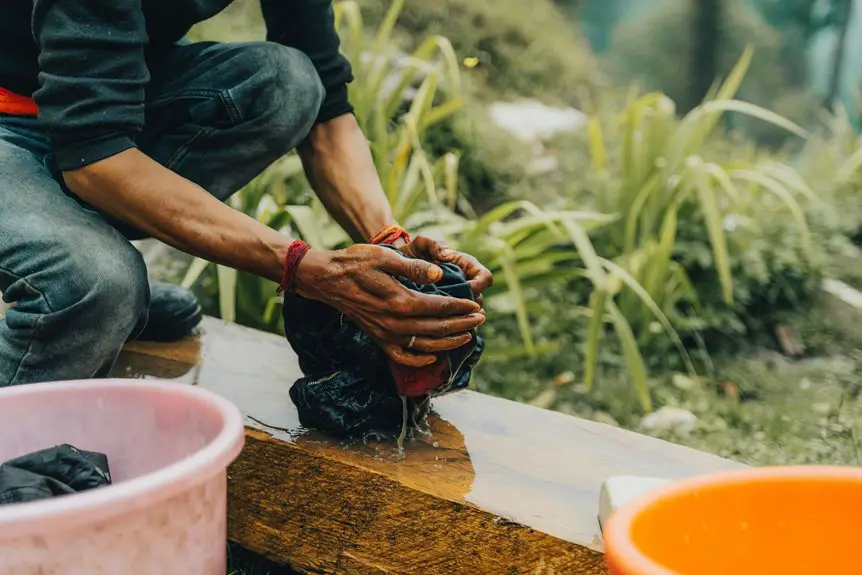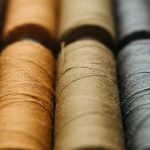To sterilize polypropylene fabric, use controlled heat like steam at 121°C or hot water below 90°C to avoid damage, or apply UV-C light for quick disinfection without harming fibers. You can also try chemical sterilants but watch for fabric weakening. Always handle with sterile gloves and store the fabric in a clean, dry place to keep it sterile. If you want to guarantee the best results and avoid common pitfalls, there are important precautions and methods you’ll find helpful.
Table of Contents
Key Takeaways
- Use controlled steam sterilization at 121°C to effectively sterilize polypropylene without causing damage or deformation.
- Limit heat exposure time and avoid temperatures above 134°C to maintain fabric integrity and prevent melting.
- Apply UV-C light for 15–30 minutes as a chemical-free, non-damaging sterilization method with even coverage.
- Store polypropylene fabric in a clean, dry, sealed environment and handle with sterile gloves to maintain sterility.
- Inspect fabric regularly for discoloration, brittleness, or stiffness to detect and address sterilization-related damage early.
Understanding Polypropylene Fabric Properties
Polypropylene fabric stands out for its durability, resistance to moisture, and lightweight nature.
When you work with it, you’ll notice it doesn’t absorb water like other fabrics, which helps prevent mold and mildew buildup. It’s also highly resistant to chemicals and stains, making it ideal for repeated use in demanding environments.
Because it’s lightweight, you won’t feel weighed down when wearing or handling it.
However, you should remember that polypropylene has a relatively low melting point compared to other fabrics, so exposing it to high temperatures can cause damage.
Knowing these properties helps you handle the fabric properly and choose appropriate sterilization methods that won’t compromise its integrity or functionality.
Common Sterilization Methods for Polypropylene
You’ll find several effective ways to sterilize polypropylene fabric, including heat-based methods like autoclaving, chemical agents such as hydrogen peroxide, and UV light exposure.
Each method has its own benefits and limitations depending on your specific needs.
Let’s explore how these options work and when to use them.
Heat-Based Sterilization Options
Although heat can effectively sterilize many materials, you need to be cautious when applying it to polypropylene fabric because excessive temperatures may cause damage.
Polypropylene has a melting point around 160°C (320°F), so avoid autoclaving or dry heat sterilization methods that exceed this. Instead, consider using controlled steam sterilization at lower temperatures, typically around 121°C (250°F), for short durations to minimize fabric distortion.
Alternatively, you can use hot water immersion between 70°C and 90°C for at least 30 minutes, which kills many pathogens without harming the fibers.
Always check the fabric’s specifications before applying heat and test a small sample first. Proper heat application can sterilize polypropylene while preserving its integrity and functionality.
Chemical Sterilization Agents
Chemical sterilization agents offer a versatile alternative to heat-based methods when treating polypropylene fabric. You can use various chemicals to effectively sterilize without damaging the material’s integrity. However, you need to choose agents compatible with polypropylene to avoid degradation.
| Agent | Effectiveness | Precautions |
|---|---|---|
| Ethylene Oxide | High against spores | Requires ventilation |
| Hydrogen Peroxide | Broad spectrum | May cause discoloration |
| Peracetic Acid | Fast-acting | Corrosive; handle carefully |
| Alcohol (70%) | Moderate | Flammable; less effective on spores |
| Chlorine-based | Strong disinfectant | Can weaken fibers over time |
Select the proper agent based on your sterilization needs and always follow safety guidelines to protect both fabric and yourself.
UV Light Application
Besides chemical agents, UV light offers an effective way to sterilize polypropylene fabric without introducing moisture or chemicals that might affect the material.
When you use UV-C light, it disrupts the DNA of bacteria and viruses, rendering them inactive. To apply this method, place the fabric under a UV-C lamp for a recommended duration, typically 15 to 30 minutes, depending on the lamp’s intensity.
Make sure the light reaches all surfaces evenly, as shadowed areas mightn’t get fully sterilized. Always follow safety precautions by avoiding direct skin or eye exposure to UV-C rays.
This method is quick and doesn’t degrade polypropylene’s properties, making it ideal for reusable items like masks or protective gear.
UV sterilization is a clean, efficient option when you want to avoid chemicals.
Using Autoclaving to Sterilize Polypropylene
When you use an autoclave to sterilize polypropylene fabric, you’ll need to set the temperature, pressure, and duration carefully to avoid damage.
Typically, temperatures around 121°C with specific pressure and time settings work best.
Make sure your material is compatible with these conditions to maintain its integrity.
Autoclave Temperature Settings
Although polypropylene can withstand high temperatures, you need to carefully set your autoclave to avoid damaging the fabric. Typically, polypropylene tolerates autoclave temperatures up to 121°C (250°F) without melting or warping.
Set your autoclave to this standard sterilization temperature, as going higher risks compromising the fabric’s integrity. Avoid exceeding 134°C (273°F), which can cause deformation.
Make certain your autoclave’s temperature settings are accurate and stable throughout the cycle to guarantee effective sterilization without fabric degradation.
Also, consider the fabric’s thickness and weave, as denser polypropylene may handle heat differently. By controlling the temperature precisely, you’ll maintain the durability and function of your polypropylene fabric while achieving the sterilization you need.
Duration and Pressure Guidelines
To effectively sterilize polypropylene fabric using an autoclave, you’ll want to maintain a pressure of around 15 psi and a duration of 15 to 30 minutes. This guarantees thorough sterilization without damaging the fabric. Shorter times might not kill all pathogens, while longer exposures can weaken fibers.
Here’s a quick reference for pressure and time settings:
| Pressure (psi) | Duration (minutes) | Result |
|---|---|---|
| 10 | 20 | Incomplete sterilization |
| 15 | 15 | Effective sterilization |
| 15 | 30 | Thorough sterilization |
| 20 | 15 | Risk of fabric damage |
| 15 | 45 | Potential fiber weakening |
Stick to 15 psi and 15-30 minutes to balance safety and effectiveness.
Material Compatibility Considerations
Since polypropylene has a specific melting point and structural properties, you need to assure your autoclaving settings won’t compromise the fabric’s integrity.
To guarantee compatibility, consider these key points:
- Temperature Limits: Polypropylene melts around 160°C, so keep autoclave temperatures below this, typically at 121°C or 134°C, to avoid deformation.
- Moisture Sensitivity: Autoclaving uses steam, which can affect the fabric’s mechanical strength if exposure is prolonged; stick to recommended cycle durations to preserve durability.
- Additives and Blends: Check if the polypropylene fabric contains additives or is blended with other fibers, as these can alter heat tolerance and reaction to steam.
Chemical Sterilization Techniques
When you need to sterilize polypropylene fabric without exposing it to high heat, chemical sterilization offers an effective alternative.
You can use agents like ethylene oxide gas, hydrogen peroxide vapor, or liquid disinfectants such as alcohol and bleach solutions. Ethylene oxide is widely used for its ability to penetrate materials deeply without damaging fibers, but it requires proper aeration afterward to remove residues.
Hydrogen peroxide vapor is another gentle option that kills microbes quickly and leaves no harmful residue. If you choose liquid disinfectants, make sure they’re diluted properly and avoid prolonged exposure to prevent fabric degradation.
Hydrogen peroxide vapor sterilizes quickly without residue; dilute liquid disinfectants to protect polypropylene fabric integrity.
Always rinse thoroughly and dry the fabric completely. Remember to work in a well-ventilated area and wear protective gear to handle chemicals safely.
Chemical sterilization preserves polypropylene’s integrity while effectively eliminating contaminants.
Advantages and Disadvantages of Heat Sterilization
Although heat sterilization is a common method for disinfecting polypropylene fabric, you should weigh its benefits against potential drawbacks.
Here’s a quick look at what heat sterilization offers and where it might fall short:
- Effectiveness: Heat kills a wide range of microbes quickly, making it very reliable for sterilization.
- Environmental Impact: This method doesn’t involve chemicals, so it’s eco-friendly and leaves no residue.
- Material Sensitivity: Polypropylene can handle moderate heat, but excessive temperatures risk warping or weakening the fabric.
Precautions to Avoid Damage During Sterilization
To protect your polypropylene fabric during sterilization, you need to carefully control the temperature and duration of heat exposure. Excessive heat or prolonged exposure can cause melting, warping, or loss of fabric strength. Always verify the fabric’s heat tolerance before starting. Avoid direct contact with heating elements and guarantee even heat distribution. Humidity levels also matter; too much moisture can affect the fabric’s integrity.
| Precaution | Reason | Tip |
|---|---|---|
| Limit heat to ≤121°C | Prevents melting/deformation | Use autoclave with precise control |
| Avoid long exposure | Maintains fabric strength | Set timer strictly |
| Use protective layer | Protects from direct heat | Place fabric in sterilization pouch |
Following these precautions will help maintain your fabric’s quality during sterilization.
Best Practices for Maintaining Sterile Polypropylene
Protecting your polypropylene fabric during sterilization sets the stage for keeping it sterile afterward. To maintain its sterility, follow these best practices diligently:
- Store Properly: Keep the fabric in a clean, dry, and sealed environment. Use sterile packaging or containers to prevent contamination.
- Handle with Care: Always wear sterile gloves when touching the fabric. Avoid exposing it to unsterile surfaces or airborne particles.
- Limit Exposure: Only remove the fabric from its sterile packaging when necessary. Minimize handling time to reduce the risk of contamination.
Troubleshooting Common Sterilization Issues
When you encounter issues during the sterilization of polypropylene fabric, it’s important to identify the root cause quickly to prevent compromising the material’s integrity.
If you notice discoloration or brittleness, check if the temperature exceeded recommended limits—polypropylene can warp or degrade under excessive heat.
If residual odors linger, confirm your sterilization method uses appropriate ventilation or rinsing steps.
For incomplete sterilization, verify the exposure time and sterilant concentration are adequate.
Avoid using harsh chemicals that can weaken fibers.
If fabric stiffness occurs, consider reducing drying temperatures or using gentler sterilization methods like gas plasma.
Always inspect fabric before and after sterilization to catch damage early.
Addressing these common issues promptly will help you maintain polypropylene’s durability and sterility.
Frequently Asked Questions
Can Polypropylene Fabric Be Safely Sterilized at Home?
You might think sterilizing at home is risky, but you can safely sterilize polypropylene fabric with careful methods like boiling or steam. Just avoid harsh chemicals and high heat to keep it intact and germ-free.
How Does Sterilization Affect the Fabric’S Breathability?
Sterilization can slightly reduce polypropylene fabric’s breathability by altering its fiber structure. You might notice less airflow or increased stiffness, especially after high-heat methods, so choose gentle sterilization to maintain comfort and function.
Are There Eco-Friendly Sterilization Options for Polypropylene?
Sustainable sterilization solutions, like steam or UV light, can safely sanitize polypropylene without sacrificing the environment. You’ll find these eco-friendly options effective, reducing chemical use and supporting a safer, greener sterilization strategy.
Can Sterilized Polypropylene Fabric Be Reused Multiple Times?
You can reuse sterilized polypropylene fabric multiple times, but its durability depends on the sterilization method used. Some processes may degrade the material, so always check for damage before reuse to guarantee safety and effectiveness.
Does Sterilization Impact the Color or Texture of Polypropylene?
You might notice slight changes in color or texture after sterilizing polypropylene, especially with harsh methods. However, gentle techniques help preserve its look and feel, so always choose sterilization carefully to avoid damage.
- Tetron Fabric for Marine Applications: Durability and Use Cases - June 18, 2025
- Tetron Fabric for Outdoor Furniture: Weather Resistance and Care - June 18, 2025
- Tetron Fabric for Wall Coverings: Style and Application Tips - June 18, 2025







